
The Evolution of Umbrella Fashion: From Victorian Times to Modern Day
16 July, 2024
Umbrellas have long been a staple accessory, not just for practicality in inclement weather, but also as a fashion statement. The evolution of umbrella fashion from the Victorian era to the present day reveals much about changing aesthetics, technological advancements, and social norms. In this extensive exploration, we'll look at how they have transformed from functional items to fashion statements and reflecting broader societal trends and innovations.
Victorian Elegance: More Than Just Rain Protection
The Victorian era, spanning from 1837 to 1901, witnessed a transformation in the perception and use of umbrellas, elevating them from mere rain protectors to symbols of elegance and social status. This period's fascination with intricate craftsmanship and luxury is vividly reflected in the design and use of umbrellas.
Materials and Craftsmanship
Wood and Whalebone Framework: The structure was predominantly made from wood and whalebone. Whalebone, owing to its flexibility and strength, was an ideal material for the ribs and stretchers of umbrellas, providing durability and a certain elegance in their silhouette.
Silk Canopies: Silk, a material associated with luxury and high status, was commonly used for the canopy. Its smooth texture and sheen made it a popular choice, though it required careful maintenance as silk was less water-resistant and more prone to wear and tear than modern materials.
Design and Decoration
Intricate Handles: The handles were often works of art in themselves, crafted from fine materials like ivory, ebony, or even mother-of-pearl. They were sometimes encrusted with jewels, engraved with intricate patterns, or fashioned into elaborate shapes, reflecting the owner's wealth and taste.
Precious Metals and Stones: Adding to the opulence, some featured gold or silver tips and ferrules (the cap at the end of the umbrella). Precious stones could be embedded in the handle for additional embellishment.
Lace and Embroidery: Especially on parasols, which were used more for sun protection and as a fashion accessory by women, lace and embroidery were common. These features added a delicate, feminine touch to the design.
Gendered Usage and Fashion
Heavier Umbrellas for Men: Men's umbrellas were sturdier and heavier, designed to be both practical and a symbol of masculinity. They were often in darker colours, with less embellishment, and had a larger size for better protection against the elements.
Ornate Umbrellas for Women: Women's, on the other hand, were lighter and more decorative. They were not just practical items but also important fashion accessories, often coordinated with outfits. The designs for women included brighter colours, intricate patterns, and finer details.
Social Significance
Status Symbols: Owning an elegant umbrella was a sign of social standing. It indicated not only the owner's wealth but also their sophistication and adherence to fashion trends.
Fashion Statements: They were integrated into fashion ensembles, contributing to the overall aesthetic appeal. They were often featured in portraits and fashion plates of the era, indicating their importance in Victorian fashion.
Public and Private Use: While they served a practical purpose in public, they were also used in social settings like garden parties, strolls in public parks, and other outdoor social events, where they were as much a part of the social scene as the attire.
In essence, the Victorian umbrella was a fusion of function, fashion, and craftsmanship, reflecting the era's values and aesthetics. It symbolised a time when even the most practical items were imbued with elegance and artistic expression.
Emergence of the Parasol
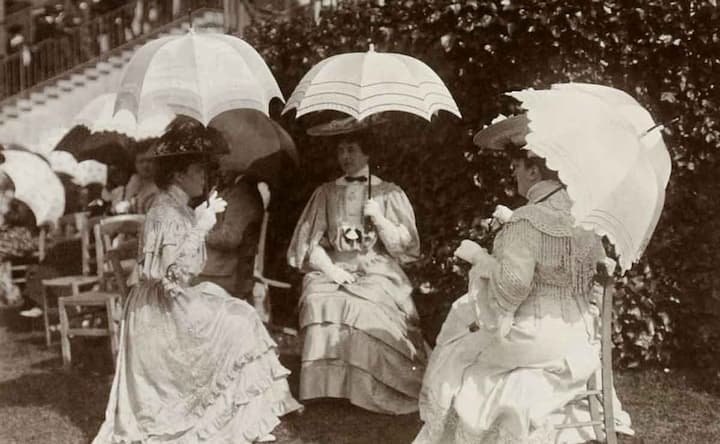
During the Victorian era, the parasol emerged as a fashionable accessory, indispensable to a lady's outdoor attire. Unlike umbrellas, which were designed for rain protection, parasols were primarily used for shielding from the sun. Their design, materials, and cultural significance highlighted the era's fashion sensibilities and social customs.
Design and Aesthetics
Size and Shape: They were generally smaller and lighter than umbrellas, making them easier to carry and more suitable for delicate use. Their shape was often more varied, including pagoda, bell-shaped, and even scalloped edges, reflecting the era's love for intricate designs.
Colourful and Decorative: In contrast to the often somber hues of umbrellas, parasols were made in a variety of bright and pastel colours. This vibrancy allowed women to coordinate them with their outfits, turning them into a fashion statement.
Materials: The canopies of parasols were usually made from fine fabrics like silk, taffeta, or lace. These materials were chosen not just for their aesthetic appeal but also for their ability to provide shade while still maintaining a degree of elegance.
Craftsmanship and Ornamentation
Lace and Embroidery: Lace detailing and embroidery were common embellishments on parasols. These decorations added a feminine touch and showcased the intricate needlework that was highly valued in Victorian times.
Frills and Ruffles: Many featured frills and ruffles along the edges, adding to their decorative appeal. These elements enhanced the parasol’s movement and visual impact, making it a dynamic part of a woman's ensemble.
Handles: The handles of parasols were often ornately crafted from materials like ivory, mother-of-pearl, or fine woods. They were sometimes carved or inlaid with jewels, making each parasol a unique piece of art.
Cultural and Social Aspects
Sun Protection and Beauty Standards: Their primary purpose was to protect a woman's skin from the sun. Pale skin was highly valued as a beauty standard and a sign of social status, indicating that one did not have to toil outdoors.
Symbol of Femininity and Elegance: Carrying one was associated with femininity, grace, and elegance. It was an accessory that highlighted a woman’s delicate beauty and adherence to fashion norms.
A Tool for Social Display: They were not just practical accessories; they were also used for social display in outdoor events, garden parties, and promenades. A well-chosen parasol could enhance a woman's presence and showcase her taste and status.
Coordination with Fashion: The practice of matching them with one's outfit underscored the importance of a coordinated and complete look in Victorian fashion. It reflected the era's attention to detail and the holistic approach to dressing.
It was much more than a tool for sun protection; it was an integral part of a woman's wardrobe, reflecting the era's fashion, craftsmanship, and societal norms. It stood as a symbol of elegance, femininity, and social status, encapsulating the delicate balance between functionality and fashion.
Early 20th Century: Practicality Meets Style
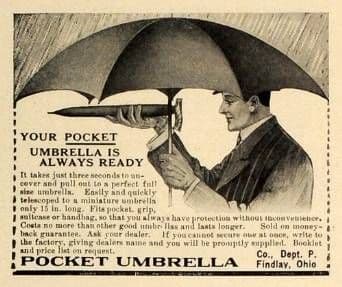
The dawn of the 20th century, particularly the Edwardian era (1901-1910), marked a significant shift in the design and perception of umbrellas. This period is characterised by the blending of practicality with style, as technological advancements made them more accessible and convenient for the general public.
Introduction of the Collapsible Umbrella
Technological Innovation: The most noteworthy advancement was the development of the collapsible umbrella. This design allowed it to be folded into a compact size, making it significantly more portable than its predecessors.
Materials and Manufacturing: The collapsible style was made possible by advancements in materials and manufacturing processes. Steel, a stronger and lighter material than whalebone, began to be used for the ribs and shaft. This not only made them more durable but also easier to fold and carry.
Impact on Accessibility: With its advent, owning and carrying an umbrella became more feasible for the average person. This shift played a crucial role in making them a common accessory beyond the upper classes.
Design and Fashion Integration
Simpler, More Functional Designs: The focus on functionality led to simpler designs. While still elegant, they lacked the ornateness of Victorian designs, reflecting the Edwardian era's more practical approach to fashion.
Diversification in Styles and Colours: Despite the emphasis on practicality, there was still a variety of styles and colours. They began to be produced in a broader range of colours, allowing for some degree of personal expression and coordination with outfits.
Gender Distinctions Persist: Although less pronounced than in the Victorian era, gender distinctions in designs continued. Men's umbrellas were generally sturdier and more subdued in colour, while women's umbrellas were lighter and often featured more decorative elements.
Broader Societal Impact
Everyday Necessity: They transitioned from being luxury items to everyday necessities. They became essential for people from all walks of life, especially in urban settings where walking was a common means of transportation.
Changing Social Norms: Their widespread use reflected broader changes in society, including increased outdoor activities and the growing importance of public life. It became a symbol of the modern, urban individual.
World War Influence: The outbreak of World War I in 1914 also impacted production, with materials like steel becoming scarce and redirected for military use. This scarcity led to further simplification in design and an emphasis on durability over aesthetics.
The early 20th century marked a pivotal point in its evolution, where practicality began to take precedence over pure ornamentation. The introduction of the collapsible umbrella was a key development, reflecting and accommodating the changing lifestyles and needs of people during this era. Its transition from a luxury item to an everyday necessity symbolised the broader societal shifts towards modernity and practicality in daily life.
The Influence of War and Rationing
The two World Wars had profound impacts on many aspects of daily life, including the fashion and design of umbrellas. World War I (1914-1918) and World War II (1939-1945) were periods marked by material scarcity and shifting social dynamics, both of which influenced the evolution of its design and usage.
Material Scarcity and Alternative Resources
Shortage of Metals and Silk: During both wars, materials such as metal and silk, previously used in its manufacturing, were in high demand for military purposes. This scarcity necessitated the search for alternative materials.
Use of Alternative Materials: Manufacturers turned to materials like wood, cotton, and synthetic fabrics that were more readily available and less critical to war efforts. These materials, while not as durable or luxurious as metal and silk, allowed for continued umbrella production.
Simpler Designs: The focus shifted from aesthetics to practicality due to these material constraints. They became simpler and more utilitarian, with less emphasis on decorative features and more on durability and function.
Changing Gender Roles and Fashion
Blurring of Gender Distinctions: As women took on roles traditionally held by men during the wars, this shift was reflected in fashion, including umbrella designs. Women's became more similar to men's in terms of durability and simplicity.
Practicality Over Ornamentation: The need for practical clothing and accessories in wartime meant that umbrellas were more about function than fashion. This change marked a departure from the gender-specific, ornate designs of the past.
Wider Usage Among Women: With more women engaging in outdoor work and activities, the use of umbrellas increased among female populations. It became a symbol of the changing role of women in society.
Post-War Impact
Continuation of Simplified Designs: Even after the wars, the trend of simpler, more functional ones continued. The economic challenges of the post-war periods meant that practicality remained a priority over luxury in design.
Increased Durability and Innovation: The constraints of war led to innovations in durability and design that continued to influence its manufacturing in the post-war era.
Post-War Era: A Burst of Colour and Innovation
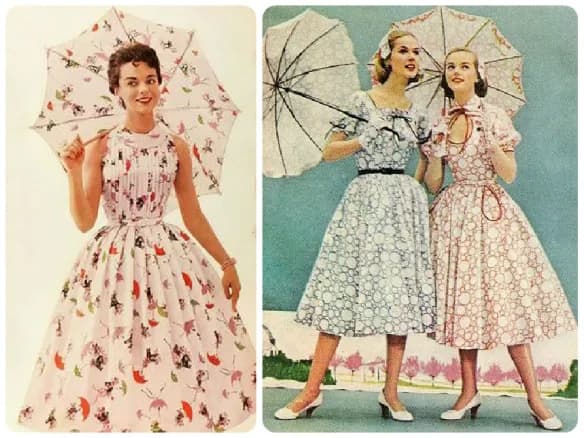
The post-war era, especially the 1950s and 1960s, heralded a significant transformation. This period was characterised by a renewed sense of optimism and creativity, leading to notable changes in the design and perception of umbrellas.
Advent of Synthetic Materials
Introduction of Nylon and Plastic: The development and widespread use of synthetic materials like nylon and plastic revolutionised its manufacturing. These materials were not only more durable and water-resistant than their predecessors but also lighter and easier to handle.
Enhanced Durability and Lightness: Ones made with synthetic materials were more robust against the elements and less prone to deterioration. Their lightness also made them more portable and user-friendly, appealing to a broader range of consumers.
Explosion of Colour and Pattern
Variety of Colours: One of the most striking features of the post-war was the extensive range of colours they came in. Unlike the subdued tones of the war years, they showcased bright, vibrant hues, reflecting the era's optimistic spirit.
Diverse Patterns: Alongside solid colours, they also began to feature a variety of patterns – from geometric shapes and floral prints to abstract designs. This diversity allowed them to become more expressive and personalised accessories.
Fashion Accessory and Statement Piece
Complementing Outfits: They started to be seen not just as protective gear but as an integral part of fashion ensembles. People began coordinating them with their outfits, using them to complement or accentuate their personal style.
Bold Statements: For many, it became a medium to make a fashion statement. Whether through a bright pop of colour or a unique pattern, they could showcase individuality and fashion-forward thinking.
Societal and Cultural Reflections
Post-War Optimism: The bold and innovative designs in this era mirrored the general sense of relief and optimism following the hardships of the war years. People were eager to embrace colour, innovation, and fun in their lives, and this was reflected in their choice of accessories.
Changing Social Dynamics: The 1950s and 1960s were times of significant social change, including the rise of youth culture and the beginnings of the consumer society. These changes were echoed in the fashion industry, becoming more accessible and appealing to a younger demographic.
Technological Progress and Consumerism: The advancements in materials and manufacturing techniques also symbolised the rapid technological progress of the time. It became a symbol of modernity and consumer choice.
The post-war era brought a burst of colour and innovation. The introduction of synthetic materials, combined with a societal shift towards optimism and expression, transformed them from mere practical items into fashion statements. This period set the stage for the diverse and expressive designs we see today, highlighting the accessory's ability to evolve with the times and reflect prevailing cultural moods.
The Swinging Sixties and Beyond

The 1960s, often referred to as the "Swinging Sixties," was a decade marked by dramatic social change, cultural revolutions, and a distinct shift in fashion and design paradigms. This transformative period greatly influenced fashion, leading to some of the most iconic and memorable designs in umbrella history.
Emphasis on Individual Expression
Vibrant Colours: Continuing from the post-war era, the 1960s saw an even greater explosion in the use of bright, eye-catching colours. Ones in neon hues or deep, saturated colours became popular, reflecting the decade's daring fashion sense.
Psychedelic Patterns: In line with the popular art and design styles of the time, they featured psychedelic patterns, including swirls, abstract motifs, and bold graphic prints. These designs were not just fashion statements but also expressions of the era's experimental and free-spirited ethos.
Innovative Shapes: They experimented with various shapes and forms. This innovation included different canopy shapes, such as square or asymmetric designs, challenging the traditional round form.
The Clear Dome Umbrella: A Symbol of Futuristic Optimism
Introduction and Popularity: One of the era's most distinctive styles was the clear dome umbrella. Its transparent material and unique dome shape offered practical visibility and full coverage, while also appearing futuristic and stylish.
Futuristic Design: It was more than just a practical item; it was a symbol of the era's fascination with the future and space-age aesthetics. Its clear canopy was like a window into a more optimistic, forward-looking world.
Cultural and Fashion Icon: It became an icon of 1960s fashion, often seen in the hands of celebrities and fashionistas. It captured the essence of the era's fashion: bold, innovative, and unapologetically modern.
Reflecting the Cultural Revolution
Youth Culture and Fashion: The 1960s was a time when youth culture came to the forefront, challenging traditional norms and values. This cultural shift was reflected in the daring and unconventional designs of the period.
Consumerism and Mass Production: The decade also saw the rise of consumerism and mass production. Umbrellas became more widely available and affordable, allowing more people to participate in fashion trends.
Global Influences: The 1960s was a time of global awareness and cross-cultural influences, reflected in the eclectic designs and patterns seen in fashion. From ethnic prints to pop art, they mirrored the decade's diverse artistic influences.
The 1960s marked a significant period in the evolution of umbrella fashion, characterised by bold colours, psychedelic patterns, and innovative designs. The clear dome umbrella, in particular, became a symbol of the era, encapsulating its optimistic outlook and groundbreaking spirit. This period's influence on umbrella fashion set a precedent for creativity and individual expression that continues to inspire designs to this day.
The Umbrella in Contemporary Fashion
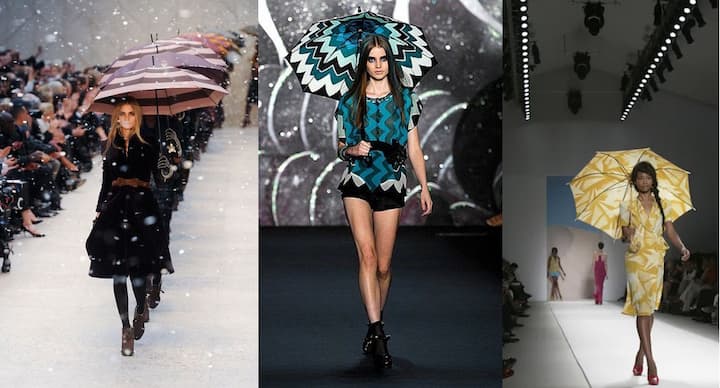
In the realm of contemporary fashion, they have transcended their traditional role as mere protectors against the rain. They have become an integral part of fashion statements, reflecting the creativity and diversity of modern design. This evolution highlights how they are now perceived and used in the fashion industry.
Integration into High-Fashion Collections
Designer Umbrellas: High-end fashion designers have embraced them as accessories worthy of artistic and creative expression. They often feature in runway shows and high-fashion collections, bearing the unique signatures and aesthetics of the designers.
Luxury Materials and Craftsmanship: Contemporary designer oens are made from luxury materials, including high-quality fabrics, leathers, and even innovative new materials. The craftsmanship involved is often meticulous, with attention to detail akin to other luxury fashion items.
Experimentation in Design
Shapes and Sizes: Modern styles come in a variety of shapes and sizes, moving away from the standard round canopy. Designers play with asymmetrical shapes, oversized canopies, and even compact designs that challenge the conventional notion of what it should be.
Diverse Materials: Beyond the traditional nylon and polyester, they use a range of materials, including eco-friendly fabrics, transparent plastics, and high-tech water-repellent coatings.
Bold Patterns and Prints: Reflecting current trends in fashion, they now feature bold patterns, prints, and colour palettes. From minimalist designs to flamboyant artistic prints, they cater to a wide range of personal styles.
Personal Style Statement
Accessorising with Outfits: It is often chosen to complement or contrast with an outfit, much like a piece of jewellery or a handbag. It becomes part of the overall look, contributing to the individual’s style statement.
Customisation and Personalisation: With the rise of customisation, some brands offer personalised umbrellas, where customers can choose colours, prints, and even add monograms or custom designs.
Cultural and Social Significance
Reflection of Social Trends: They often reflect broader social and cultural trends, such as sustainability, technological integration, and global influences.
Inclusivity and Diversity: It embraces inclusivity, and this is evident in the designs that cater to a diverse range of tastes, styles, and cultural backgrounds.
Artistic Collaborations: There is a growing trend of collaborations between manufacturers and artists or graphic designers, resulting in limited-edition pieces that are as much art as they are fashion accessories.
The Evolution of Umbrellas in Promotional Use
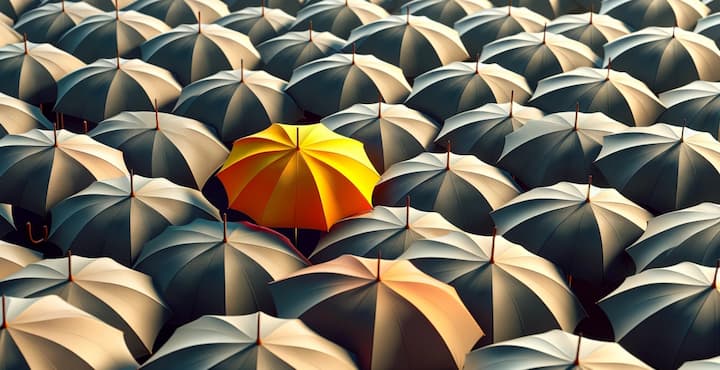
The journey of umbrellas from simple rain protectors to pivotal elements in promotional strategies is a fascinating aspect of their evolution. This change parallels developments in marketing trends and technological advancements, offering a unique lens through which to view the intersection of practicality and advertising.
Early Use in Marketing
Initial Functionality: Initially, they served a fundamental purpose in promotions - as practical items protecting against the rain. Businesses would typically do custom logo umbrellas, using it as a modest tool for brand exposure.
Simple Branding: Early branding was usually straightforward, often just a company logo or name, reflecting the primary goal of functionality over elaborate marketing.
Mid-20th Century: A Shift Towards Bold Advertising
Introduction of Bold Designs: As the advertising industry expanded, companies began to see umbrellas as more than just practical items. By the mid-20th century, there was a shift towards using them as active marketing tools, featuring bold colours and designs.
Advancements in Printing Technology: This era saw significant improvements in printing technology, enabling businesses to imprint high-resolution, full-color images and intricate designs on the canopies.
Modern Era: Sophistication and Innovation
Innovative Features: In recent times, they have become increasingly sophisticated. Innovations include LED lighting, interactive components, and digital connectivity. These features transform them from mere advertising tools to engaging, interactive experiences for users.
Focus on Brand Storytelling and User Experience: Modern ones are not just about brand visibility; they have evolved into storytellers, engaging customers in unique and memorable ways and enhancing user experience.
The evolution of umbrellas in promotional use is a testament to their versatility and enduring appeal. From basic rain shields with simple logos to sophisticated marketing tools equipped with modern technology and eco-friendly materials, they have adapted and thrived in the ever-evolving landscape of advertising and consumer engagement.
Conclusion: An Ever-Evolving Accessory
Its history is a fascinating journey through time, reflecting changes in technology, society, and style. From the Victorian era’s ornate designs to today’s eco-friendly and high-tech versions, they have continually evolved, mirroring the times. They are a testament to human ingenuity and our desire to blend practicality with style.
The umbrella, it seems, will always be with us, evolving and adapting, a small but significant part of our sartorial history and future.
The Umbrellas Only Team
